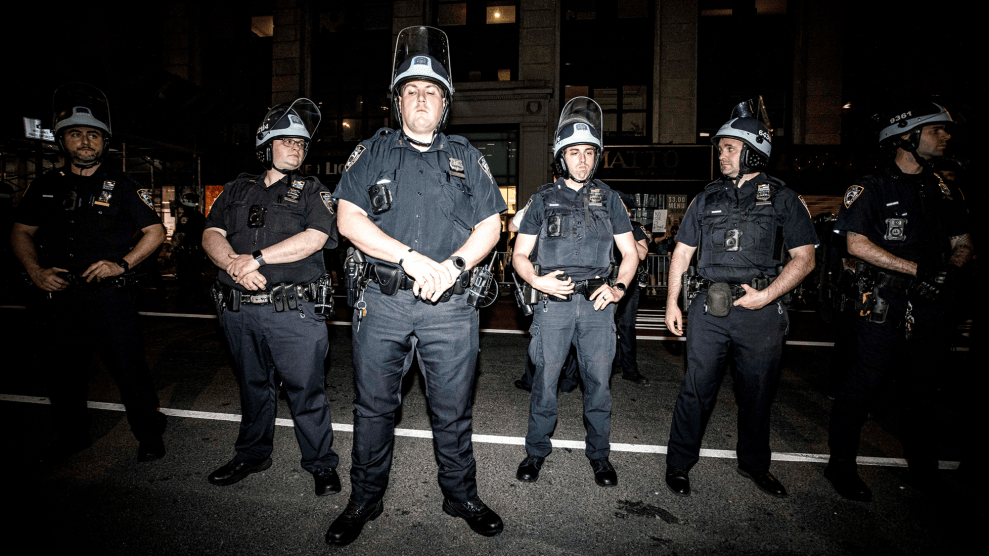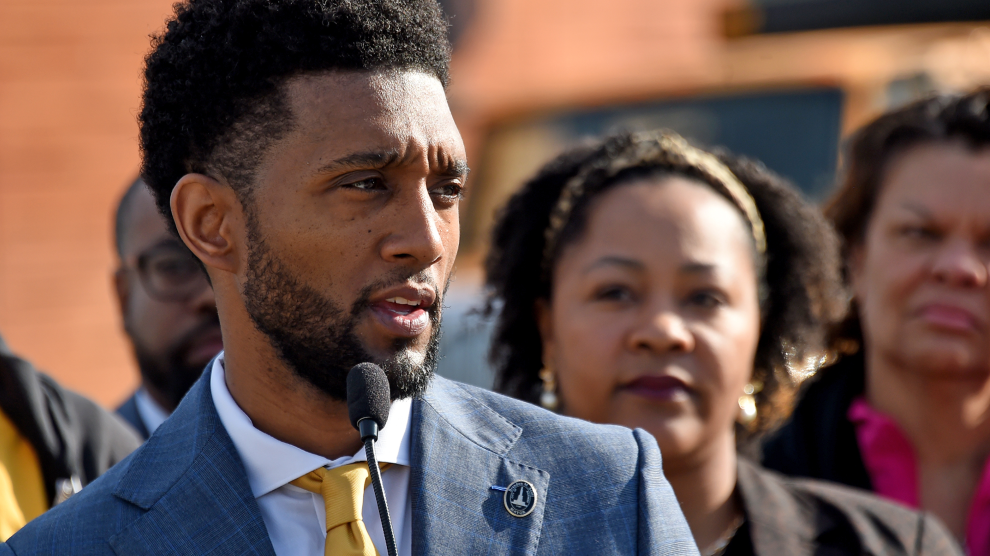
Police and protesters gather outside of a Brownsville Brooklyn subway station following a shooting on Sunday of a subway fare evader on September 17, 2024, in New York City. Spencer Platt/Getty
On Sunday, two New York City police officers fired into a crowded Brooklyn subway station, shooting and injuring four people, including two bystanders, one of whom is a hospital employee now in critical condition after police shot him in the head during his commute.
The catalyst for this bloody confrontation: an alleged fare evasion. In other words, $2.90.
According to the NYPD, officers suspected that 37-year-old Derell Mickles had skipped a turnstile at the Sutter Avenue subway station in Brooklyn. The officers followed Mickles, resulting in a chase that ended with officers shooting him, two bystanders, and another officer on duty. While police initially claimed that they had recovered a knife Mickles had used to threaten officers, officials later contradicted their own claim, prompting questions over what exactly had happened.
Asked about body camera footage on Tuesday, Mayor Eric Adams deflected, telling a reporter to “speak with the police commissioner,” before praising the officers involved in Sunday’s shooting for demonstrating a “great level of restraint.” The NYPD has since firmly defended the officers, with the police departments chief of patrol stating, “We are not perfect.”
The violent incident, inside one of the world’s busiest subway systems, has sparked outrage among New Yorkers as well as a victim’s family members, who condemned the officers’ actions as “reckless.”
And they’re far from alone. Criminal justice reform advocates are slamming what they see as an outsized response by the NYPD to something as minor and trivial as alleged fare evasion. It comes amid New York Mayor Eric Adams’ aggressive crackdown on fare evaders, a policy Adams has claimed would also help with violence that occurs on trains. Protests have since broken out across the city, calling for the officers involved in Sunday’s shooting to be held accountable.
I spoke with Michael Sisitzky, assistant policy director at the New York City Civil Liberties Union, to learn more about Adams’ crackdown on fare evasion, overpolicing, and lack of police transparency surrounding Sunday’s violent encounter. Our conversation has been edited for length and clarity.
This is an ongoing investigation. But there are already significant concerns over how the police handled this situation and how the mayor has responded.
This disturbing incident is sadly not surprising, given what we’ve seen from this administration. The Adams administration and NYPD have been dramatically ramping up enforcement activity, increasing their presence in the subways, increasing stops, increasing frisks, and increasing all of the hallmarks of broken windows policing. This is a predictable and inevitable consequence of this administration’s approach to a very aggressive enforcement mindset. There are so many questions about what we’ve heard from the mayor’s office from the NYPD about what exactly unfolded.
We have heard officer accounts of what happened. We’ve heard some witness accounts. The NYPD and the mayor’s office have been reviewing body camera footage. But, we have not been able to see this. We’re not getting a transparent accounting of what took place. It’s absolutely critical that we see the evidence that they’re relying on to make these assertions.
We’re being asked to take the word of a mayor whose initial tweet in response to this incident had to get community noted because it was leaving out the important context of the officer he was talking about having been shot was shot by a fellow officer. We can’t really trust their version of events when they’re not showing us the evidence of what took place in that incident.
This is a predictable and inevitable consequence of this administration’s approach to a very aggressive enforcement mindset.
Are complaints over transparency from the NYPD common?
It’s a hallmark of the NYPD. We know that they can be transparent when they choose to be and when they think it serves their interest. Folks may remember back in January of 2024 the NYPD released body camera footage within hours, within a day of the traffic stop of a city council member when they sought to use that footage to highlight their version of what took place. But they treat incidents like this very differently.
How common—or rare—are shootings like this in New York?
I don’t know that we have the full stats on how common this type of shooting is in the subway from an officer. It’s not something that I’ve seen a full accounting of, but what we have seen are increased reports of police misconduct and abuse of New Yorkers that have upticked with this administration. Civilian complaints going into the Civilian Complaint Review Board have reached alarmingly high levels. At the same time, there have also been real concerns about what the department is actually doing with complaints that are moving through the NYPD disciplinary system, where they’re just not taking those reports seriously.
When you respond to everything with an officer, you are increasing the likelihood that we’re going to see more cases where someone is subject to use of force.
Can overpolicing backfire? How do outsize police presences affect communities, particularly communities of color?
The approach that this administration has taken since day one is overpolicing.
They’ve identified police officers as the be-all, end-all, sole solution to every societal ill. Fare evasion? Send a cop after it. Homelessness? Send police to conduct sweeps. Mental health crises? Instead of sending peers and EMTs, send a cop instead.
It’s a formula that this administration seems wedded to, but it’s not improving community safety for New Yorkers. Police are primarily concerned with enforcing criminal laws, making arrests, and issuing summonses. They have an enforcement mindset, not a delivery of services or addressing root causes mindset.
So when you respond to everything with an officer, you are increasing the likelihood that we’re going to see more and more cases where someone is subject to use of force, someone is tased, someone is shot, someone is killed when they did not need to be, because you are responding to a situation with tools that are just fundamentally not a good fit for that scenario.
We see this play out largely in communities that need more investments to address the root causes of crime, poverty, homelessness, the need for increased mental health and healthcare services. Rather than making those investments, which are harder and will take more thought to accomplish, we instead default to a reliance on police officers.
In March, the NYPD announced they would send 800 officers into subways to combat fare evasion. In the same month, Gov. Kathy Hochul deployed the National Guard in response to several violent incidents that occurred a few weeks prior. Realistically, how effective are methods like this in preventing crime, and what are some of the pitfalls?
It’s brought up time and time again that if you focus on low-level crime and low-level signs of disorder, you’re mitigating the potential for it to escalate into more serious criminal activity and driving down overall crime rates as a result.
That’s been studied and debunked numerous times. New York City hit historically low crime rates as stop and frisk plummeted to historic lows and was reined in as enforcement fell, as summonses and arrest activity went down. The data is just not there to justify the approach to broken windows or quality-of-life policing.
Instead, it’s very effective at funneling more and more people into the criminal legal system, saddling people with fines that they cannot afford, making them attend court dates that they cannot afford, and giving people the potentially lifelong consequence of acquiring a criminal record which can extend to every aspect of their life. What it’s not doing is meeting community needs and making New Yorkers safer.
Eric Adams has pushed for a crackdown on fare evasion. Last month, the MTA announced that they’ll be sending summons of up to $50 to $100 to fare evaders. Did a “tough on crime” approach play into what happened over the weekend?
What happened over the weekend is an inevitable outcome of that kind of tough-on-crime approach, where the only tool that we seem to have to offer is police officers, who are going to focus on enforcement and if they’re given an aggressive mandate to enforce, are going to enforce that aggressively.
We haven’t seen the actual footage yet. We’re relying on accounts of what happened. But it’s very easy to see how a police officer pursuing someone, chasing them, is a tactic that is escalatory, as opposed to thinking of ways we can tackle issues like fare evasion without the threat of violence.
That is such a mismatch we don’t need to be constrained thinking about responding to fare evasion with just a police law enforcement tool.
We should be thinking more broadly about getting people access to the support they need to enroll in programs for New Yorkers who can’t afford to pay for fares to get to work, pay for child care, or get access to medical care. We can think about other ways that we are addressing those causes without putting armed officers in and telling them you need to make sure that you are aggressively cracking down on everyone within the system.
As this case has gained traction on social media, one of the most disturbing responses I’ve seen is how so many people justify using this level of force because Mickles was suspected of evading a $2.90 fare. It’s a narrative that oftentimes rears its head after a high-profile case of police brutality. We saw this with George Floyd, Eric Garner.
The level of force used here is so disproportionate to the alleged infraction. No one should be subject to having their life put in jeopardy because of an alleged evasion of a $2.90 cent fare, to say nothing of the fact that officers pursued him into a crowded station and onto a train.
That response is not only out of proportion to the individual’s alleged offense, but it is putting so many other people needlessly in harm’s way.
It’s deeply disturbing that the NYPD and the administration could view that level of a response as an appropriate reaction when we’re talking about something as trivial as the evasion of a $2.90 cent fare.
Since the shooting occurred, plenty of New Yorkers have started to protest the NYPD’s crackdown on fare evasion. What are your thoughts on some of these demonstrations?
People are recognizing an uptick in the targeting of their communities and an uptick in stop activity racial disparities as bad or even worse than they were at its height. There is a real sense that the NYPD is not providing a service to New Yorkers but is causing active harm In communities.
And I think that an expression that also finds a voice in the number of complaints of police misconduct going in, being on the rise, and is evident in the types of protests that we’re seeing against this incident and against other instances of police brutality and violence.
It’s important that New Yorkers be able to express their to raise their voice and express their views in protesting against policies that are causing harm in their communities rather than actually helping deliver real safety for them.














